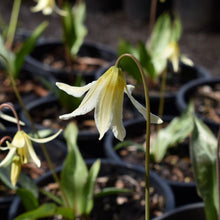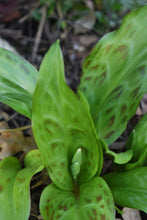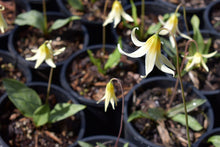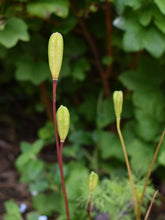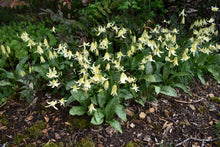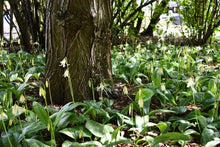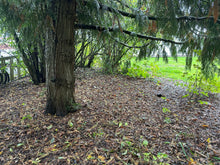
Erythronium oregonum
White fawn lily, also known as Oregon fawn lily is one of the showiest wildflowers out there. It is a spring ephemeral, meaning it packs a stunning punch of beauty into a relatively short period of time. First, its thick basal leaves will fascinate with their dappled brown markings, which many say are reminiscent of a fawn's spotted coat. By April, nodding flower buds will rise several inches above the leaves, eventually elating you as they unfurl into creamy white star-shaped flowers that attract and support butterflies, bees and other insect pollinators.
- Plant type/canopy layer: deciduous, perennial, herbaceous plant
- Size at maturity: 12" tall, 6-8" wide
- Light requirements: full sun to part shade
- Moisture requirements: moist soil, prefers well-drained
- Bloom Time: March - June (April - May in the Portland Metro area)
- Growth rate/ease: medium growth rate, moderately difficult to grow
- Wildlife support: flowers attract and provide nectar for adult butterflies, bees and other insect pollinators
- Native habitat/range: common in meadows and open woodlands, at low to mid-elevations up to 1800m, in western Oregon from the Coast Range to the Cascades, north through Washington to British Columbia. Portland Plant List - yes.
- Special features & uses: landscape uses include pollinator gardens, rock gardens and woodland gardens
What to Expect + Gardening with White Fawn Lily: White Fawn Lily is a perennial bulb that blooms in spring then dies back completely. In a natural setting, it typically forms a carpet of breathtaking blooms - so be sure to plant in bulk if you’d like this effect.
For spring orders, depending on the weather and the date of your order pick-up, bulbs may be just emerging or already dying back for the season. Bulbs can be fragile when they're actively growing in spring. So, either plant with care or keep it in its pot and wait until it dies back before planting. By early summer, the plant will die back completely and the bulb will be easy to transplant. If you go this route, leave the pot in a sheltered place and water sparingly, so that you don't rot the bulb. For fall orders, you can expect what looks like a pot of dirt. The bulb inside may appear slightly shriveled, which is its normal, dormant fall look. Fall is generally considered an excellent time to plant bulbs.
Interplant with other herbaceous plants, shrubs and/or ferns to compliment the look and fill the space once the fawn lily is finished for the season.
Photo Credits: Nikkie West, Sparrowhawk Native Plants








